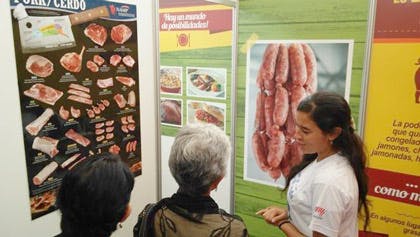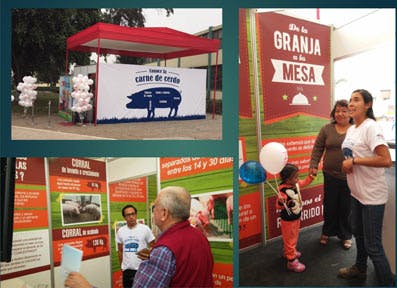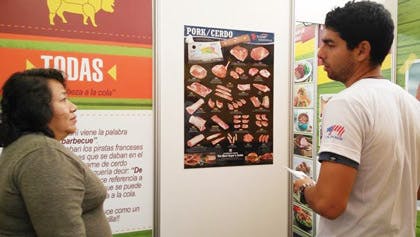Peruvian Consumers Get Fresh Look at U.S. Pork

Consumers and USMEF representatives discussed the quality and versatility of U.S. pork during “Chicharron Day” in Lima, Peru
To demonstrate the quality and safety of U.S. pork and to promote and encourage increased pork consumption in South America, USMEF participated in a “Chicharron Day” event in Lima, Peru. Funding support for the promotion was provided by the Pork Checkoff.
Peru is a relatively small market for U.S. pork, but demand has been growing. In 2011, pork exports to Peru were just 400 metric tons (mt) valued at less than $1 million. By 2014, exports had grown to 1,672 mt valued at $4.5 million, and those numbers were already surpassed in the first half of 2015, as exports to Peru reached 1,968 mt valued at $5.1 million.
Adding to the increasing optimism in the Peruvian market is the fact that the USDA announced this spring that negotiations with Peru's Servicio Nacional De Sanidad Agraria (SENASA) had resulted in greater access for U.S. fresh and chilled pork. Revised certification options for U.S packing companies are expected to greatly expand opportunities for U.S. pork in Peru’s rapidly growing retail and foodservice sectors.

U.S. pork production practices and food safety were major parts of USMEF’s presentation at the Lima event.
Consumers in Peru are becoming big fans of pork, as evidenced by events like Chicharron Day. Chicharron refers to succulent pork – usually pork belly – that is braised and then fried in its own fat. The sandwich is often piled onto a roll with fried sweet potatoes and a spicy onion salsa. It is especially popular as a breakfast meal served with coffee.
The Chicharron Day event in Lima attracted more than 6,000 people, most of them heads of households who make purchasing and meal preparation decisions. To reach these highly valued consumers, USMEF’s booth provided information and education about U.S. pork production and handling practices. Details about U.S. pork cuts and products, along with nutritional facts and menu ideas for U.S. pork, were also shared with those in attendance.
“Our goal was to reverse any negative perception about U.S. pork and to show the important role it can play in daily meal planning,” said Jessica Julca, USMEF representative in South America. “We took an interactive approach with the display, allowing consumers to talk about their favorite cuts of pork and how it was prepared. We were able to build on those discussions and educate consumers with new ideas for preparing pork.”

New ideas for preparing pork were shared with consumers, who were surveyed about their favorite pork cuts and preparation methods
By surveying consumers about their favorite pork dishes and preparation methods, USMEF was also able to identify important preferences. Thirty percent of men and 40 percent of women identified ribs as their favorite pork cut. Fifteen percent of men preferred tenderloin, while 30 percent of women ranked pork chops as their second-favorite cut. Ham was selected by about 10 percent of both men and women.
As for preparation methods, 45 percent of women and 34 percent of men listed “chicharron” as their favorite. Stew was next in line for women (16 percent) while men chose grilling (9 percent).
